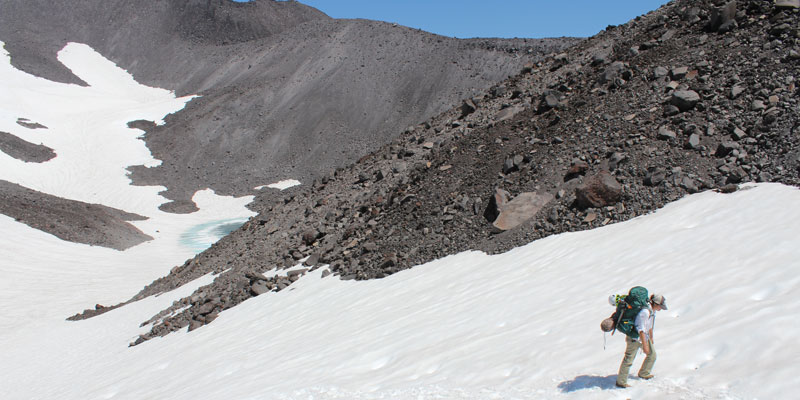A new study will examine how microbial communities living in the snow and ice pack impact glacial melt.

Trinity Hamilton conducting field work at Mt. Hood. Photo Credit: Jeff Havig
Trinity Hamilton, assistant professor in Plant and Microbial Biology, recently teamed up with colleague Marty Frisbee, an assistant professor at Purdue University. The research team — with Frisbee as the lead PI — will take a closer look at glacial melt in Glacier National Park and Mount Hood with the help of a new National Science Foundation grant.
Glaciers wax and wane annually. In the summer months, water, nutrients and microbes flow down slope. During the winter months, the glaciers pack on more snow and ice. Due to climate change, alpine glaciers are now melting at a faster rate than ever before. The researchers want to understand how quickly they will disappear and the subsequent impact on surrounding communities.
To better understand the rate at which glaciers are receding, scientists develop models, taking into account how quickly glaciers receded in the past. “Currently none of the glacial melt models include a biotic component,” says Hamilton. “Over the past decade, we’ve learned that microbes impact snow and ice melt. We hope to learn more about how microbes impact glacial melt and how their communities change as the glacier changes.”
In addition to informing projections on how quickly glaciers are receding, the research will also help scientists assess the impact of glacial loss on downstream communities. Microorganisms, plants and animals evolved with seasonal increases in water and carbon, thanks to the glaciers at higher elevations. This influx is increasing with rapidly melting glaciers, but will eventually stop entirely once they disappear. The potential impacts on communities are largely unknown.
Taylor Price, a new Plant and Microbial Biology Ph.D. student in the Hamilton lab will focus on how glacier-living microbes impact their downstream communities. The team will return to the field next summer where they’ll work to capture precipitation before it lands on the glacier or streams.
—Claire Wilson